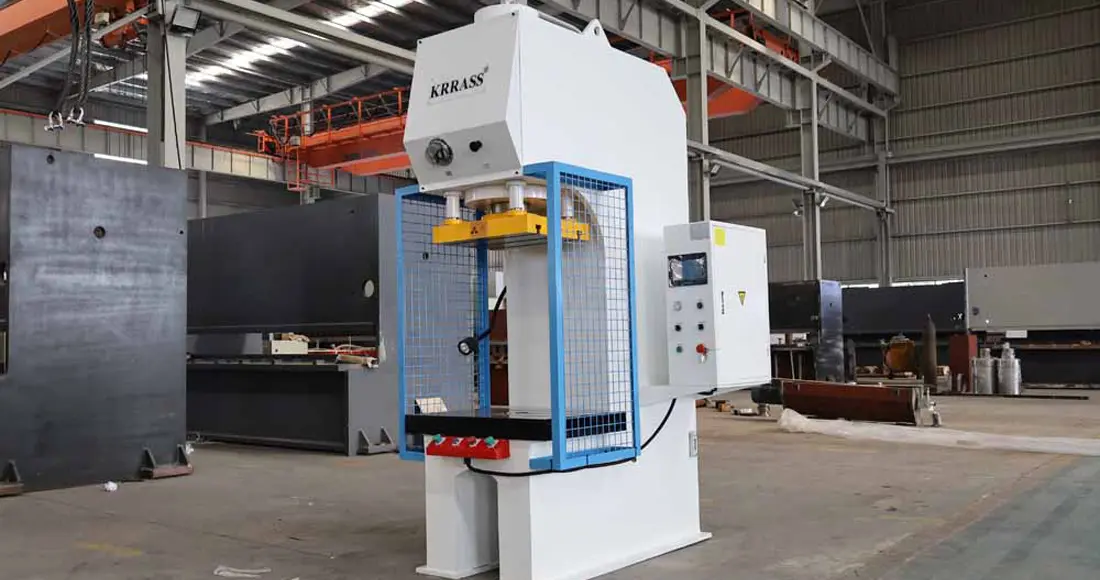Welcome to the ultimate guide on punch presses! In this comprehensive article, we will explore the principle, types, parameters, and uses of punch presses, ensuring you have all the information you need to make informed decisions for your manufacturing needs. Whether you're in the market for a punch press, hydraulic press, or simply curious about these powerful machines, you're in the right place.
- What is a Punch Press?
- What are the Main Components and Parts of a Punch Press?
- How Does a Punch Press Work?
- What are the Main Technical Parameters Associated with a Punch Press?
- What are the Supported Materials for a Punch Press?
- What are the Advantages of a Punch Press?
- What are the Applications of a Punch Press?
- What are Potential Hazards and Dangers of a Punch Press?
- How Much Does a Punch Press Cost?
- How to Choose a Punch Press Machine?
- What are Alternative Machines to the Punch Press?
- How to Choose a Punch Press Manufacturer?
What is a Punch Press?
When we delve into the world of machinery, one of the most essential tools that we come across is a punch press. But what exactly is a punch press? A punch press is a type of machine that uses a punch and die to form shapes out of sheets of metal or other materials. The basic principle involves the punch, a tool made of hard material, moving through a die to cut, form, or draw the workpiece into the desired shape.
The versatility of punch presses is quite impressive. From creating holes to forming shapes, the capabilities are vast. The primary use of punch press is in the manufacturing industry, where it plays a pivotal role in shaping materials to specific designs. When seeking a reliable punch press, it's essential to consult a reputable punch press manufacturer who can provide you with a machine that meets your specific requirements.
It's also important to note that there are various types of punch presses, including mechanical, hydraulic, and CNC (computer numerical control) presses. Each type brings its own set of advantages and is suitable for different applications. The choice of a punch press ultimately depends on the specific needs of the task at hand, such as the material to be processed, the required precision, and the desired production speed.
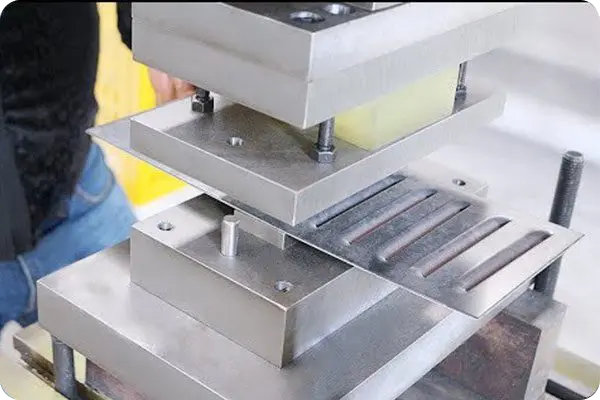
What are the Main Components and Parts of a Punch Press?
A punch press is an intricate machine composed of numerous parts, each playing a crucial role in its operation. Let's explore the main components that make up a punch press.
Ram
The ram is a movable component that delivers the force required to cut or shape the workpiece. It is attached to the punch and moves in a vertical direction to perform the stamping operation.
Frame and Worktable
The frame provides support to the entire machine and maintains its stability during operation. The worktable is where the material to be processed is placed. It is crucial for holding the workpiece securely in place during the stamping process.
Drive and Control Mechanism
This component is responsible for powering and controlling the machine. The drive mechanism converts energy into motion to facilitate the movement of the ram, while the control mechanism allows the operator to manipulate the machine's operation according to the required specifications.
Punch and Die
The punch and die are two of the most critical components in a punch press. The punch is a hard tool that moves through the die to cut or shape the workpiece. The die is a complementary tool that provides the necessary resistance to shape the workpiece as per the desired design.
Brakes
Brakes are essential for controlling the movement of the ram. They ensure that the ram stops at the correct position, ensuring precision and safety during operation.
Flywheel
The flywheel is a significant energy storage device in a punch press. It stores rotational energy and releases it to power the machine, ensuring a consistent flow of energy for the machine's operation.
Bolster Plate
The bolster plate provides support to the die and ensures that it remains in the correct position during the stamping operation. This is vital for achieving the desired precision and quality of the final product.
How Does a Punch Press Work?
A punch press is an industrial machine designed to cut, form, or draw materials into specific shapes by using a tool called a punch. The punch press operates through a process that combines force and precision to achieve the desired result. Let's take a closer look at how this fascinating machine works.
The working of a punch press can be broken down into a series of steps:
1. Setting Up the Machine:
The first step involves setting up the machine for the specific task at hand. This includes selecting and installing the appropriate punch and die, adjusting the ram height, and setting the stroke length. The workpiece is then placed on the worktable, positioned correctly in relation to the die.
2. Operation:
Once the machine is set up, the operator starts the punch press. The drive mechanism powers the ram, moving it in a vertical direction. As the ram descends, the punch attached to it also moves down, passing through the die. This action cuts or forms the workpiece into the desired shape.
3. Ejecting the Workpiece:
After the stamping process is complete, the workpiece is ejected from the die, and the ram returns to its original position. The final product is then inspected to ensure it meets the required specifications.
4. Repeat the Process:
The machine is now ready for the next cycle. The process is repeated for each workpiece until the desired quantity is achieved.
The precision and efficiency of a punch press make it an essential tool in various industries, including automotive, aerospace, and electronics manufacturing. It is vital to consult a reputable punch press manufacturer to ensure you receive a machine that aligns with your specific needs and expectations.
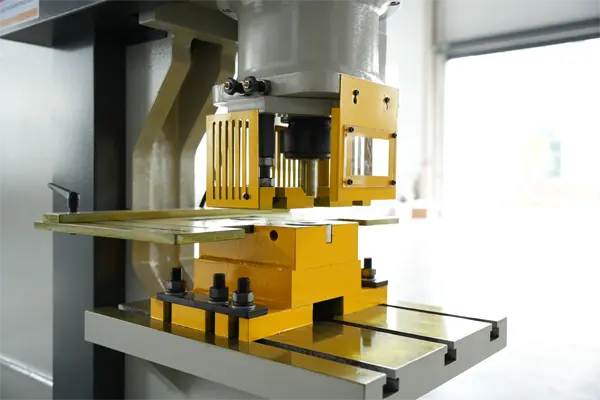
What are the Main Technical Parameters Associated with a Punch Press?
A punch press is a versatile and vital tool in the manufacturing industry, and its performance is influenced by a range of technical parameters. These parameters vary based on the type of punch press, including flywheel drive, mechanical drive, hydraulic drive, servo drive turret, and CNC punch presses. Let's explore the main technical parameters associated with each type of punch press.
Flywheel Drive Punch Press:
The flywheel drive punch press is characterized by its use of a flywheel to store and release energy for the operation. Key technical parameters for this type of punch press include flywheel speed, energy storage capacity, and power transmission efficiency.
Mechanical Drive Punch Press:
The mechanical drive punch press utilizes gears and other mechanical components to transmit power from the motor to the ram. Important technical parameters for this type of punch press are gear ratios, power transmission efficiency, and mechanical wear and tear.
Hydraulic Drive Punch Press:
Hydraulic drive punch presses use hydraulic fluid to transmit power from the motor to the ram. The key technical parameters for this type of punch press include hydraulic fluid pressure, flow rate, and the efficiency of the hydraulic system.
Servo Drive Turret Punch Press:
Servo drive turret punch presses are known for their precision and versatility. The main technical parameters for this type of punch press include servo motor speed, torque, and the accuracy of the control system.
CNC Punch Press:
CNC punch presses are the most advanced type, utilizing computer numerical control to achieve high precision and automation. The crucial technical parameters for this type of punch press include processing speed, positional accuracy, and the flexibility of the control system.
What are the Supported Materials for a Punch Press?
A punch press is a versatile machine used in various industries to shape and cut materials into specific forms. The range of materials that can be processed by a punch press is vast and includes metals, plastics, composites, and more. Let's delve deeper into the supported materials for a punch press.
Metals:
Metals are the most common material processed by punch presses. This includes:
- Steel: Both mild and stainless steel can be punched, cut, and shaped using a punch press.
- Aluminum: Lightweight yet strong, aluminum is commonly processed by punch presses in various industries.
- Copper, Brass, and Bronze: These non-ferrous metals are also suitable for processing with a punch press.
Plastics:
Plastics, including thermoplastics and thermosetting plastics, can be processed by a punch press. This is commonly seen in the automotive and electronics industries.
Composites:
Composites, such as fiberglass and carbon fiber composites, can also be processed by punch presses. These materials are used in aerospace, automotive, and sporting goods industries.
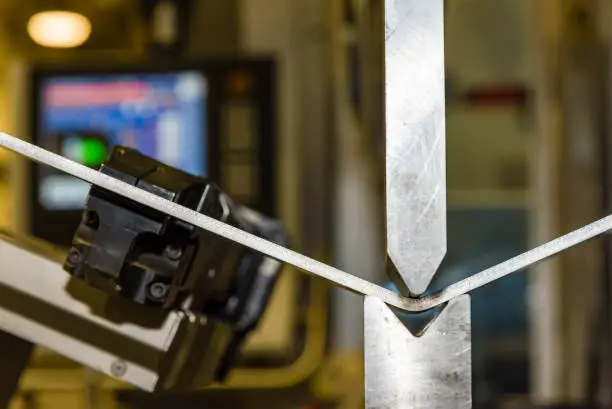
What are the Advantages of a Punch Press?
A punch press is an invaluable tool in the manufacturing sector, offering a plethora of benefits that significantly enhance production capabilities. From precision and repeatability to economic aspects, let's dive into the advantages of using a punch press.
Precision and Repeatability:
One of the most significant benefits of a punch press is its precision and repeatability. A punch press can achieve tight tolerances and produce parts with consistent quality, ensuring every piece meets the required specifications.
Production Speed and Efficiency:
A punch press can significantly increase production speed and efficiency. Automated processes and rapid punch cycles contribute to faster turnaround times, enabling higher productivity levels.
Versatility in Materials and Shapes:
Punch presses are incredibly versatile, capable of handling a wide range of materials, including metals, plastics, and composites. They can also produce complex shapes and intricate designs, catering to various industry needs.
Economical Aspects and Operating Costs:
Punch presses are cost-effective, with lower operating costs compared to other machining processes. They also reduce the need for secondary operations, further minimizing expenses. In addition, the longevity and durability of punch presses contribute to long-term savings.
Additional Advantages to Consider:
Additional benefits of punch presses include their compact size, which requires less floor space, and the availability of customizable tooling options. Furthermore, punch presses are user-friendly, with easy setup and operation, making them accessible to a broader range of users.
What are the Applications of a Punch Press?
The punch press is a versatile machine that plays a crucial role in various industries. Its ability to cut, shape, and form materials into precise parts and components makes it indispensable for many applications. Let's take a closer look at the diverse applications of a punch press.
Automotive Industry:
The automotive industry relies heavily on punch presses to manufacture numerous parts, such as body panels, frames, and other components. The precision and efficiency of punch presses allow for the rapid production of these parts, keeping up with the industry's high-demand production schedules.
Electronics Industry:
Punch presses are utilized in the electronics industry to create components like circuit boards, connectors, and housings. The ability to produce small, intricate parts with precision is crucial in this field, where components often have complex geometries.
Aerospace Industry:
In the aerospace industry, punch presses are used to produce components such as brackets, panels, and other structural elements. These parts must meet strict quality and precision standards, making the punch press an ideal tool for their production.
Construction Industry:
The construction industry also benefits from the capabilities of punch presses. They are used to create various components, such as metal studs, beams, and other structural elements that form the backbone of buildings and infrastructures.
Medical Industry:
In the medical field, punch presses are employed to manufacture medical devices and equipment, such as surgical instruments, implants, and other precision tools. The ability to produce parts with tight tolerances is crucial in this industry, where even the slightest deviation can have significant consequences.
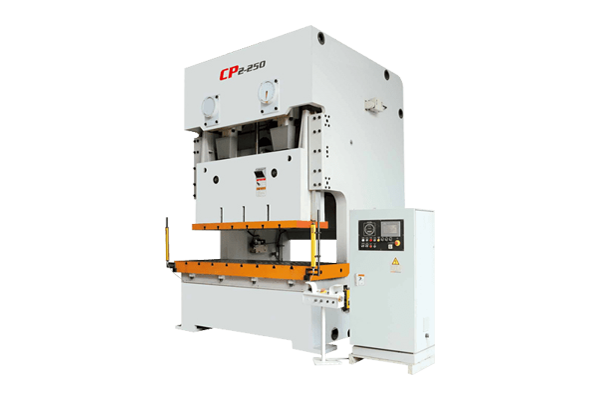
What are Potential Hazards and Dangers of a Punch Press?
A punch press is an incredibly useful machine that has revolutionized the manufacturing industry. However, like any piece of heavy machinery, it comes with its own set of potential hazards and dangers. Let's explore some of the risks associated with operating a punch press and how to mitigate them.
Injury from Moving Parts:
One of the most common hazards associated with a punch press is injury from moving parts. The press's ram and flywheel can cause severe injuries if proper safety measures are not taken. To mitigate this risk, it is essential to use proper guarding and ensure that all safety interlocks are functioning correctly.
Ejection of Material:
Materials being processed can sometimes be ejected from the machine at high speeds, posing a risk to the operator and bystanders. To prevent this, it is crucial to use appropriate clamps and fixtures to secure the material in place during operation.
Noise and Vibration:
Punch presses can generate high levels of noise and vibration, which can lead to hearing loss and other health issues. To mitigate these risks, operators should use appropriate personal protective equipment such as earplugs or earmuffs.
Electrical Hazards:
Punch presses are powered by electricity, and thus, there is a risk of electrical shock or fire. Proper maintenance and regular inspection of the machine's electrical components can help prevent these hazards.
Improper Training:
Operating a punch press requires specialized training and knowledge. Lack of proper training can lead to accidents and injuries. It is vital that all operators are adequately trained and competent to handle the machine safely.
How Much Does a Punch Press Cost?
When it comes to purchasing a punch press, there are a variety of factors that can influence the final cost. Let's break down the different aspects that can affect the price and help you understand what to expect when investing in a punch press.
Type of Punch Press:
The type of punch press you choose is one of the most significant factors influencing the cost. There are several types of punch presses available, including mechanical, hydraulic, servo-driven, and CNC punch presses. Each type has its own set of features and benefits, and the price can vary significantly from one to another. Generally, CNC punch presses are the most expensive, given their precision and automation capabilities.
Size and Capacity:
The size and capacity of the punch press will also play a role in determining the cost. Larger machines with higher capacities will typically be more expensive than smaller, less powerful models.
Brand and Manufacturer:
The brand and manufacturer of the punch press can also impact the price. Renowned brands with a history of producing high-quality machines may charge a premium compared to less established manufacturers.
New vs. Used:
Another factor to consider is whether you are purchasing a new or used punch press. While new machines will come with the latest technology and features, they will also be more expensive. On the other hand, used punch presses can be a more cost-effective option, but it is essential to thoroughly inspect the machine and ensure it is in good working condition before making a purchase.
Additional Features and Accessories:
Finally, any additional features or accessories you choose to include with your punch press will affect the cost. Customizations and specific requirements can add to the overall price of the machine.
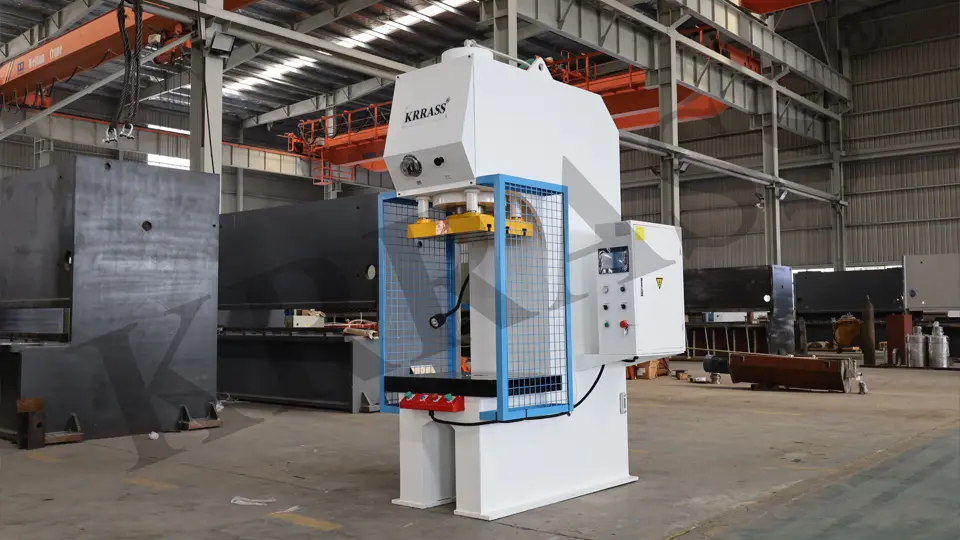
How to Choose a Punch Press Machine?
When it comes to selecting the perfect punch press machine for your manufacturing needs, the process can be overwhelming given the myriad of options available. However, by taking into consideration a few key factors, you can make an informed decision that meets your requirements and budget. Let’s dive into the specifics of how to choose the right punch press machine.
Assess Your Needs:
The first step in selecting a punch press machine is to thoroughly assess your needs. Consider the type of material you will be working with, the thickness of the material, and the complexity of the shapes you need to punch. These factors will help determine the size and capacity of the machine required.
Type of Punch Press:
There are various types of punch presses available, including mechanical, hydraulic, servo-driven, and CNC punch presses. Each type has its own set of advantages and disadvantages. Mechanical and hydraulic presses are typically less expensive than servo-driven and CNC presses but may not offer the same level of precision and automation.
Brand and Manufacturer:
The brand and manufacturer of the punch press machine are also crucial factors to consider. Opt for a reputable brand known for producing high-quality, reliable machines. Do your research and read customer reviews to make an informed decision.
Budget:
Budget is another critical factor to consider when choosing a punch press machine. While it may be tempting to opt for the cheapest option, it is essential to remember that quality should not be compromised. A more expensive machine from a reputable brand may offer better performance and longevity, ultimately providing better value for money in the long run.
After-Sales Service and Support:
After-sales service and support are also important factors to consider when purchasing a punch press machine. Look for a manufacturer that offers comprehensive customer support, including installation, training, and maintenance services. This will ensure that you have the necessary support to keep your machine running smoothly for years to come.
What are Alternative Machines to the Punch Press?
While punch presses are versatile and efficient machines for cutting and forming materials, there are several alternative machines available that may be better suited for specific tasks or applications. Let's explore some of these alternatives to help you make an informed decision for your manufacturing needs.
Laser Cutting Machines:
Laser cutting machines use a high-powered laser beam to cut and engrave materials with precision. These machines are ideal for intricate designs and complex shapes. They are commonly used for cutting metals, plastics, wood, and other materials. Laser cutting machines offer excellent accuracy and can produce fine details that may be challenging with a punch press.
Waterjet Cutting Machines:
Waterjet cutting machines use a jet of water mixed with abrasive particles to cut through materials. These machines are suitable for cutting a wide range of materials, including metals, glass, ceramics, and more. Waterjet cutting machines are known for their ability to cut thick materials with precision and produce a smooth edge finish.
Plasma Cutting Machines:
Plasma cutting machines utilize a plasma torch to cut through conductive materials like metal. They are popular in the fabrication and automotive industries for cutting steel, aluminum, and other metals. Plasma cutting machines are known for their speed and ability to cut through thick materials with ease.
CNC Milling Machines:
CNC milling machines are used for machining solid materials like metal and plastic. They use computer-controlled rotating tools to remove material and shape the workpiece. CNC milling machines are highly versatile and can produce complex shapes with precision. They are commonly used in the aerospace, automotive, and medical industries for creating intricate parts and components.
Shearing Machines:
Shearing machines, also known as guillotine shears, are used to cut straight lines on flat metal stock. They use a blade to cut through the material, producing a clean, straight edge. Shearing machines are ideal for applications that require straight-line cutting without the need for intricate shapes or patterns.

How to Choose a Punch Press Manufacturer?
Choosing the right punch press manufacturer is a crucial decision that can significantly impact your business's productivity and profitability. A reliable and high-quality machine will ensure smooth and efficient operations, while a subpar one may lead to downtime and financial losses. Here are some tips to help you make an informed choice.
Research and Reputation:
Start by researching potential manufacturers and their reputations in the market. Look for reviews and testimonials from other customers to understand their experiences. A manufacturer with a long history and positive customer feedback is likely to offer reliable and high-quality products.
Quality and Durability:
Quality and durability are crucial factors to consider when choosing a punch press manufacturer. Ask for product specifications and details to understand the materials used, production processes, and quality control measures in place. A high-quality machine made from durable materials will provide a longer service life and better performance.
Customer Support:
Effective and responsive customer support is essential, especially if you encounter any issues with your punch press machine. Look for manufacturers that offer comprehensive customer service, including installation, training, and after-sales support. A company that values its customers and is committed to their satisfaction will provide a better overall experience.
Customization Options:
Depending on your specific requirements, you may need a customized punch press machine. Check if the manufacturer offers customization options to meet your needs. A company that is willing to work with you to develop a tailored solution is likely to be more customer-oriented and committed to meeting your requirements.
Pricing:
While price should not be the sole determining factor, it is still an important consideration. Compare prices from different manufacturers and ensure you are getting value for your money. A more expensive machine may offer better quality and performance, ultimately providing a better return on investment over time.
Conclusion
In conclusion, understanding the intricacies of punch presses, from their working principle and main components to the various types and technical parameters, is essential for anyone in the manufacturing industry. By considering the advantages and potential hazards associated with these machines, as well as the cost and factors to consider when choosing a punch press, you can make a well-informed decision that meets your specific needs. When it comes to finding a reliable and high-quality punch press, look no further than Krrass, a leading manufacturer of punch press, stamping press, and hydraulic press in China. Discover the world of possibilities with Krrass by visiting their website at www.krrass.com.
Read More:
